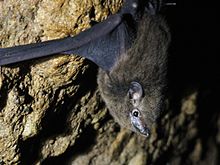
Emballonuridae is one of the twenty families of bats in the mammalian order Chiroptera and part of the microbat suborder. Members of this family are called emballonurids, and include sheath-tailed bats, sac-winged bats, and tomb bats. They are found in all continents besides Europe and Antarctica, primarily in forests and caves, though some species can also be found in shrublands, savannas, rocky areas, or deserts. They range in size from the Amazonian sac-winged bat, at 3 cm (1 in) plus a 1 cm (0.4 in) tail, to the Pel's pouched bat, at 14 cm (6 in) plus a 4 cm (2 in) tail. Like all bats, emballonurids are capable of true and sustained flight, and have wing lengths ranging from 3 cm (1 in) to 10 cm (4 in). They are all insectivorous and eat a variety of insects and spiders, and occasionally fruit.[1] Almost no emballonurid have population estimates, though three species—the Pacific sheath-tailed bat, Antioquian sac-winged bat, and Hildegarde's tomb bat—are categorized as endangered species, and one species—the Seychelles sheath-tailed bat—is categorized as critically endangered with a population as low as 50.
The 54 extant species of Emballonuridae are divided between two subfamilies: Emballonurinae and Taphozoinae. Emballonurinae contains 36 species in 12 genera, and Taphozoinae contains 18 species in 2 genera. A few extinct prehistoric emballonurid species have been discovered, though due to ongoing research and discoveries the exact number and categorization is not fixed.[2]
